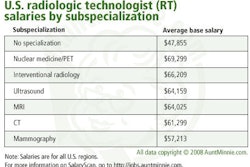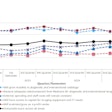Medical imaging industry groups are criticizing a new report issued this week by the U.S. Government Accountability Office (GAO) that recommends preauthorization as a means for reducing Medicare spending on medical imaging, which grew nearly 50% in six years.
The GAO issued the report to help Congress evaluate Medicare spending on imaging services in the wake of the Deficit Reduction Act (DRA) of 2005. The report tracks the growth in Medicare spending on imaging from 2000 to 2006, the relationship between rising spending and physician-office imaging, and practices that private payors have used to rein in spending.
Among the report's findings is that the Medicare Part B program spent $14.11 billion on imaging services in 2006, up 48% compared to $6.89 billion in spending in 2000. The report found a connection between in-office imaging and spending growth, with the proportion of Medicare spending on in-office imaging rising from 58% in 2000 to 64% in 2006.
Physicians are also obtaining an increasing share of Medicare revenue from imaging. For example, in 2006, cardiologists earned 36% of their total Medicare revenue from in-office imaging, compared to 23% in 2000. In addition, the report found that in 2006 Medicare spending on imaging varied widely by state, from $62 per beneficiary in Vermont to $472 per beneficiary in Florida.
"Together these trends raise concerns about whether Medicare's physician payment policies embody financial incentives for physicians to overuse imaging services," the report states.
The report goes on to examine tools used by private payors to reduce imaging overutilization and compares them to the tools used by the Centers for Medicare and Medicaid Services (CMS). Many private health plans use prospective imaging management practices that have been effective in constraining spending growth, such as requiring preauthorization for imaging studies before they can be conducted.
Private plans also use "privileging," in which plans limit their approval for imaging to physicians in certain specialties, and "profiling," in which medical claims data are analyzed in an attempt to measure an individual physician's use of services against a desired benchmark. By contrast, CMS' tools tend to be retrospective, such as through administrators who examine claims for payment after services have been rendered.
"To address the rapid growth in Medicare Part B spending on imaging services, we recommend that CMS examine the feasibility of expanding its payment safeguard mechanisms by adding more front-end approaches to managing imaging services, such as using privileging and prior authorization," the report said.
Not so fast
Imaging industry groups were quick to criticize the report's recommendation that more front-end tools are needed to control utilization. The charge is being led by two groups, the Medical Imaging and Technology Alliance (MITA) and the Access to Medical Imaging Coalition (AMIC), both of which found fault with the report's methodology.
The GAO didn't use up-to-date data, reference medical guidelines, or look at trends in which providers and payors are adopting appropriateness and accreditation criteria to address the issue of proper utilization of imaging services, making this suggestion inappropriate, according to Andrew Whitman, vice president of MITA.
"The GAO had an opportunity to look at all aspects of utilization management," he said. "They interviewed various stakeholders and did a study, but it still concluded that prior authorization is the best tool."
According to AMIC, the GAO's recommendation was built on an inadequate analysis of radiology benefit management (RBM) programs. The report did not offer any analysis of how prior authorization requirements and other physician limitations impact healthcare savings. It didn't include comment from medical professional associations, nor did it analyze what physicians have to say about their experiences with RBMs in general and prior authorizations specifically.
"Proper utilization of imaging is an important issue," said Tim Trysla, executive director of AMIC. "But instead of adopting cost limitations that will create red tape and increase inefficiencies, policymakers should work with professional medical societies to adopt appropriateness criteria."
The U.S. Department of Health and Human Services is critical of the GAO's recommendation as well, Whitman said. Much more effective is legislation that implements accreditation and appropriateness criteria policy that will address improper use of imaging without restricting imaging that's necessary.
Will the report affect the Medicare landscape? Probably not, Whitman said, especially with last week's passage of H.R. 6331, the Medicare Improvements for Patients and Providers Act of 2008, which includes measures to improve the appropriateness and quality of imaging services.
"Congress has acted to direct CMS to implement accreditation and appropriateness criteria programs," he said. "I don't think this report will have much impact."
By Kate Madden Yee
AuntMinnie.com staff writer
July 15, 2008
Related Reading
President threatens to veto Medicare bill, July 14, 2008
Physician pay cuts averted as Senate passes Medicare bill, July 10, 2008
CMS delays Medicare payments due to SGR impasse, July 1, 2008
U.S. Senate blocks Medicare bill with HMO cuts, June 27, 2008
U.S. House moves to head off SGR cuts, June 25, 2008
Copyright © 2008 AuntMinnie.com




















